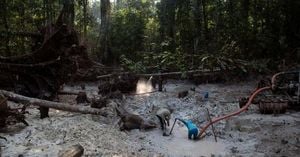Researchers investigating methods for improving degraded coal gangue soils have uncovered compelling results linking the use of biochar and polyacrylamide to enhanced soil health. Coal gangue, the byproduct of extensive mining operations, poses significant environmental challenges, including land degradation and reduced soil fertility.
This study comprehensively examined the effects of amendments—specifically biochar (BC) sourced from maize straw and polyacrylamide (PAM)—on the physicochemical characteristics and enzyme activities of coal gangue soils (CGS). During their 120-day pot incubation experiment, the researchers tested varying concentrations of biochar (1%, 2%, and 5%) alongside different levels of polyacrylamide (0.02%, 0.05%, and 0.10%). The objective was to identify optimal combinations for enhancing soil quality.
The results were significant: treatments with 5% biochar and 0.10% PAM (labeled B5P10) exhibited the lowest bulk density and the highest increase of organic carbon—an impressive 57.98% compared to untreated control soils. Soil enzymes, which play pivotal roles in nutrient cycling and organic matter decomposition, also showed remarkable activity increases. Notably, activities of enzymes such as α-glucosidase and N-acetyl-glucosaminidase surged by 112.34% and 110.77% respectively.
Such findings are particularly important as enzyme activity serves as an indicator of soil health and ecological functionality. "Soil enzymes serve as key indicators for assessing material and energy dynamics and soil quality due to their sensitivity to subtle changes," the authors noted. Their research identified soil characteristics such as pH, active carbon content, and field capacity as primary factors influencing enzyme efficiency.
Adding biochar to coal gangue soils not only enhances microhabitats for beneficial soil microorganisms but also improves moisture retention, which is particularly beneficial for arid regions affected by coal mining. Previous studies identified biochar's advantages, such as nutrient retention and increased soil organic carbon, supporting its impact on microbial activity and soil structure.
Simultaneously, polyacrylamide acts as a stabilizer, binding soil particles and preventing erosion, thereby supporting agricultural productivity. Its interaction with biochar creates optimal conditions for root development and crop health, making it increasingly attractive for soil reclamation projects.
To synthesize the key outcomes, the authors recommend incorporating 2% biochar with 0.05% polyacrylamide as the ideal formula for soil reconstruction efforts within mining regions. Such amendments present low-cost, accessible approaches for addressing soil degradation caused by coal mining.
This research is part of broader efforts to rehabilitate ecosystems impacted by heavy industry. Future work will need to extend these findings beyond controlled environments, moving to field trials to evaluate the long-term effectiveness and economic viability of these amendments suited for diverse real-world conditions.
By implementing strategies utilizing both biochar and polyacrylamide, it's possible to transform coal gangue from waste material to revitalizing soil amendments, fostering restoration of biodiversity and enhancing agricultural productivity, thereby benefiting both ecosystems and local economies.



